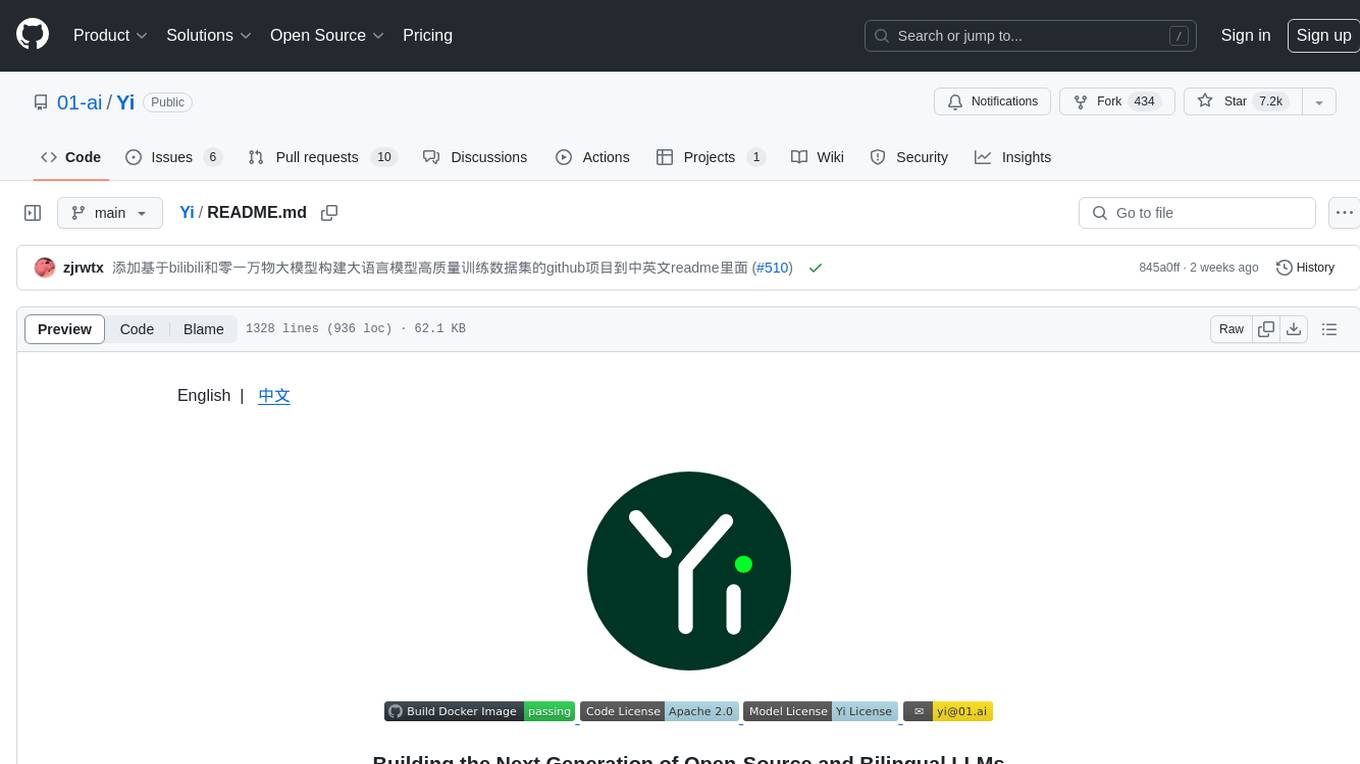
ms-swift
Use PEFT or Full-parameter to CPT/SFT/DPO/GRPO 500+ LLMs (Qwen3, Qwen3-MoE, Llama4, GLM4.5, InternLM3, DeepSeek-R1, ...) and 200+ MLLMs (Qwen3-VL, Qwen3-Omni, InternVL3.5, Ovis2.5, Llava, GLM4v, Phi4, ...) (AAAI 2025).
Stars: 10102
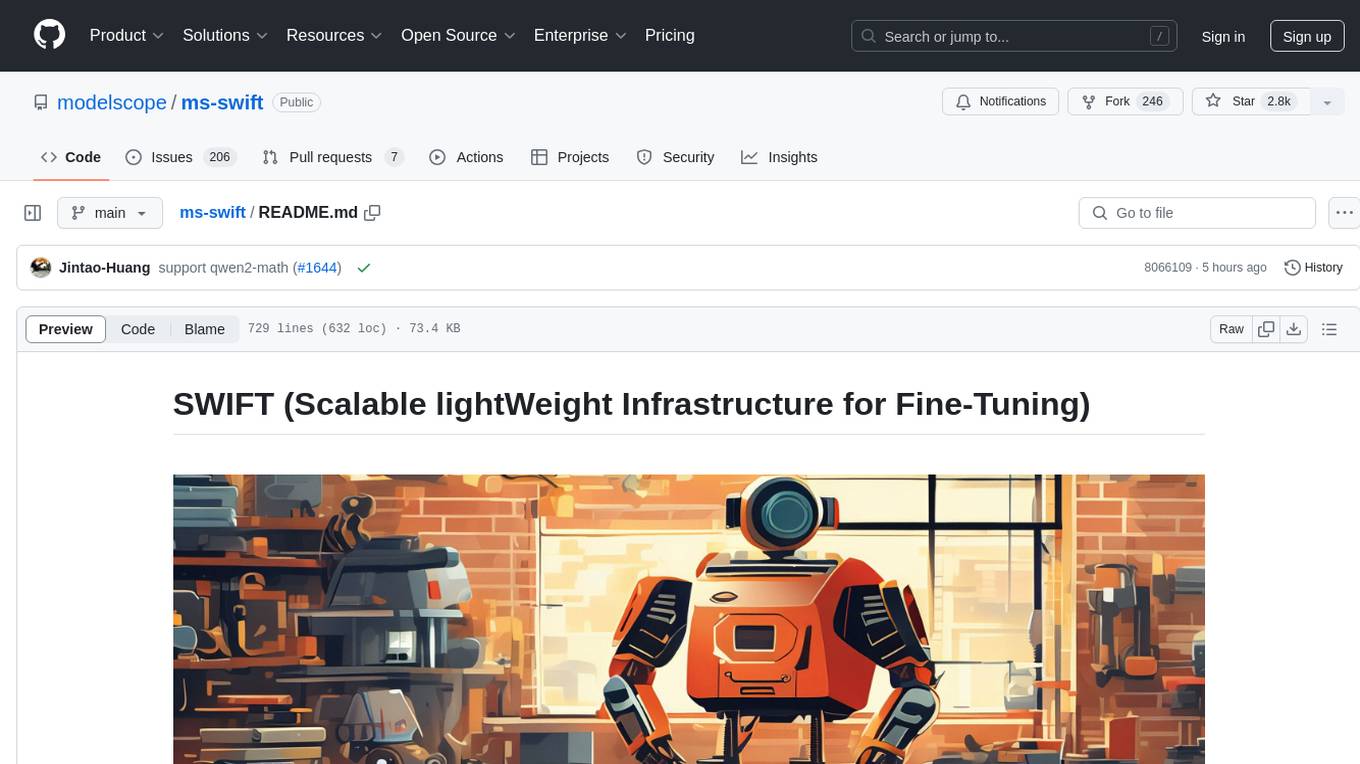
ms-swift is an official framework provided by the ModelScope community for fine-tuning and deploying large language models and multi-modal large models. It supports training, inference, evaluation, quantization, and deployment of over 400 large models and 100+ multi-modal large models. The framework includes various training technologies and accelerates inference, evaluation, and deployment modules. It offers a Gradio-based Web-UI interface and best practices for easy application of large models. ms-swift supports a wide range of model types, dataset types, hardware support, lightweight training methods, distributed training techniques, quantization training, RLHF training, multi-modal training, interface training, plugin and extension support, inference acceleration engines, model evaluation, and model quantization.
README:
ModelScope Community Website
中文   |   English  
Paper   | English Documentation   |   中文文档  
You can contact us and communicate with us by adding our group:
| Discord Group | WeChat Group |
|---|---|
 |
 |
🍲 ms-swift is an official framework provided by the ModelScope community for fine-tuning and deploying large language models and multi-modal large models. It currently supports the training (pre-training, fine-tuning, human alignment), inference, evaluation, quantization, and deployment of 500+ large models and 200+ multi-modal large models. These large language models (LLMs) include models such as Qwen3, Qwen3-MoE, Qwen2.5, InternLM3, GLM4.5, Mistral, DeepSeek-R1, Yi1.5, TeleChat2, Baichuan2, and Gemma2. The multi-modal LLMs include models such as Qwen2.5-VL, Qwen2-Audio, Llama4, Llava, InternVL3, MiniCPM-V-4, Ovis2.5, GLM4v, Xcomposer2.5, Yi-VL, DeepSeek-VL2, Phi3.5-Vision, and GOT-OCR2.
🍔 Additionally, ms-swift incorporates the latest training technologies, including lightweight techniques such as LoRA, QLoRA, Llama-Pro, LongLoRA, GaLore, Q-GaLore, LoRA+, LISA, DoRA, FourierFt, ReFT, UnSloth, and Liger, as well as human alignment training methods like DPO, GRPO, RM, PPO, GKD, KTO, CPO, SimPO, and ORPO. ms-swift supports acceleration of inference, evaluation, and deployment modules using vLLM, SGLang and LMDeploy, and it supports model quantization with technologies like GPTQ, AWQ, and BNB. Furthermore, ms-swift offers a Gradio-based Web UI and a wealth of best practices.
Why choose ms-swift?
- 🍎 Model Types: Supports 500+ pure text large models, 200+ multi-modal large models, as well as All-to-All multi-modal models, sequence classification models, and embedding models, covering the entire process from training to deployment.
- Dataset Types: Comes with 150+ pre-training, fine-tuning, human alignment, multi-modal datasets, and supports custom datasets.
- Hardware Support: Compatible with CPU, RTX series, T4/V100, A10/A100/H100, Ascend NPU, MPS, etc.
- Lightweight Training: Supports lightweight fine-tuning methods like LoRA, QLoRA, DoRA, LoRA+, ReFT, RS-LoRA, LLaMAPro, Adapter, GaLore, Q-Galore, LISA, UnSloth, Liger-Kernel.
- Distributed Training: Supports distributed data parallel (DDP), device_map simple model parallelism, DeepSpeed ZeRO2/ZeRO3, FSDP, Megatron, and other distributed training techniques.
- Quantization Training: Supports training quantized models like BNB, AWQ, GPTQ, AQLM, HQQ, EETQ.
- 🍊 RLHF Training: Supports human alignment training methods such as DPO, GRPO, RM, PPO, GKD, KTO, CPO, SimPO, ORPO for both pure text and multi-modal large models.
- 🍓 Multi-Modal Training: Supports training on different modalities like images, videos, and audio, for tasks like VQA, captioning, OCR, and grounding.
- 🥥 Megatron Parallelism: Supports accelerating CPT/SFT/DPO using Megatron parallelism techniques, currently compatible with 200+ large language models.
- Interface Training: Provides capabilities for training, inference, evaluation, quantization through an interface, completing the whole large model pipeline.
- Plugin and Extension: Supports custom model and dataset extensions, as well as customization of components like loss, metric, trainer, loss-scale, callback, optimizer.
- 🍉 Toolbox Capabilities: Offers not only training support for large models and multi-modal large models but also covers the entire process of inference, evaluation, quantization, and deployment.
- Inference Acceleration: Supports inference acceleration engines like PyTorch, vLLM, SGLang, LmDeploy, and provides OpenAI API for accelerating inference, deployment, and evaluation modules.
- Model Evaluation: Uses EvalScope as the evaluation backend and supports evaluation on 100+ datasets for both pure text and multi-modal models.
- Model Quantization: Supports AWQ, GPTQ, FP8, and BNB quantized exports, with models that can use vLLM/SGLang/LmDeploy for inference acceleration and continue training.
- 🎁 2025.09.07: Added support for CHORD training algorithm. See the documentation
- 🎁 2025.09.06: Ulysses can now be used with ring-attention, allowing sequences to be sharded into any number of chunks (no longer limited by the number of heads). The argument remains
--sequence_parallel_size N. - 🎁 2025.09.02: Megatron-SWIFT now supports multimodal model training. Documentation can be found here.
- 🎁 2025.08.12: Support Dynamic Fine-Tuning(DFT) in SFT training, use parameter
--enable_dft_loss true. Training scripts can be found here. - 🎁 2025.07.12: Deployment(pt/vLLM/SGLang) of Embedding models is supported, check here.
- 🎁 2025.07.09: Megatron-SWIFT supports LoRA training. Compared to ms-swift, it achieves significant speedup on MoE models. Training scripts can be found here.
- 🎁 2025.06.23: Fine-tuning of reranker models is supported. Training scripts can be found here: Reranker.
- 🎁 2025.06.18: Support for accelerating the ms-swift inference, deployment, evaluation, and UI modules using the sglang inference acceleration engine. Simply set
--infer_backend sglangto enable it. - 🎁 2025.06.15: Support for GKD training on both pure text large models and multimodal models. Training scripts can be found here: Pure Text, Multimodal.
- 🎁 2025.06.11: Support for using Megatron parallelism techniques for RLHF training. The training script can be found here.
- 🎁 2025.05.29: Support sequence parallel in pt, sft, dpo and grpo, check script here.
- 🎁 2025.05.11: GRPO now supports custom processing logic for reward models. See the GenRM example here.
- 🎁 2025.04.15: The ms-swift paper has been accepted by AAAI 2025. You can find the paper at this link.
- 🎁 2025.03.23: Multi-round GRPO is now supported for training multi-turn dialogue scenarios (e.g., agent tool calling). Please refer to the doc.
- 🎁 2025.03.16: Support for Megatron's parallel training techniques is now available. Please see the Megatron-SWIFT training documentation.
- 🎁 2025.03.15: Fine-tuning of embedding models for both pure text and multimodal models is supported. Please check the training script.
- 🎁 2025.03.05: The hybrid mode for GRPO is supported, with a script for training a 72B model on 4 GPUs (4*80G) available here. Tensor parallelism with vllm is also supported, with the training script available here.
- 🎁 2025.02.21: The GRPO algorithm now supports LMDeploy, with the training script available here. Additionally, the performance of the GRPO algorithm has been tested, achieving a training speed increase of up to 300% using various tricks. Please check the WanDB table here.
- 🎁 2025.02.21: The
swift samplecommand is now supported. The reinforcement fine-tuning script can be found here, and the large model API distillation sampling script is available here. - 🔥 2025.02.12: Support for the GRPO (Group Relative Policy Optimization) training algorithm has been added. Documentation is available here.
- 🎁 2024.12.04: Major update to ms-swift 3.0. Please refer to the release notes and changes.
More
- 🎉 2024.08.12: The ms-swift paper has been published on arXiv and can be read here.
- 🔥 2024.08.05: Support for using evalscope as a backend for evaluating large models and multimodal models.
- 🔥 2024.07.29: Support for using vllm and lmdeploy to accelerate inference for large models and multimodal models. When performing infer/deploy/eval, you can specify
--infer_backend vllm/lmdeploy. - 🔥 2024.07.24: Support for human preference alignment training for multimodal large models, including DPO/ORPO/SimPO/CPO/KTO/RM/PPO.
- 🔥 2024.02.01: Support for Agent training! The training algorithm is derived from this paper.
To install using pip:
pip install ms-swift -UTo install from source:
# pip install git+https://github.com/modelscope/ms-swift.git
git clone https://github.com/modelscope/ms-swift.git
cd ms-swift
pip install -e .Running Environment:
| Range | Recommended | Notes | |
|---|---|---|---|
| python | >=3.9 | 3.10/3.11 | |
| cuda | cuda12 | No need to install if using CPU, NPU, MPS | |
| torch | >=2.0 | 2.7.1 | |
| transformers | >=4.33 | 4.56.1 | |
| modelscope | >=1.23 | ||
| peft | >=0.11,<0.18 | ||
| flash_attn | 2.7.4.post1/3.0.0b1 | ||
| trl | >=0.15,<0.21 | 0.20.0 | RLHF |
| deepspeed | >=0.14 | 0.17.5 | Training |
| vllm | >=0.5.1 | 0.10.1.1 | Inference/Deployment |
| sglang | >=0.4.6 | 0.4.10.post2 | Inference/Deployment |
| lmdeploy | >=0.5 | 0.9.2.post1 | Inference/Deployment |
| evalscope | >=1.0 | Evaluation | |
| gradio | 5.32.1 | Web-UI/App |
For more optional dependencies, you can refer to here.
10 minutes of self-cognition fine-tuning of Qwen2.5-7B-Instruct on a single 3090 GPU:
# 22GB
CUDA_VISIBLE_DEVICES=0 \
swift sft \
--model Qwen/Qwen2.5-7B-Instruct \
--train_type lora \
--dataset 'AI-ModelScope/alpaca-gpt4-data-zh#500' \
'AI-ModelScope/alpaca-gpt4-data-en#500' \
'swift/self-cognition#500' \
--torch_dtype bfloat16 \
--num_train_epochs 1 \
--per_device_train_batch_size 1 \
--per_device_eval_batch_size 1 \
--learning_rate 1e-4 \
--lora_rank 8 \
--lora_alpha 32 \
--target_modules all-linear \
--gradient_accumulation_steps 16 \
--eval_steps 50 \
--save_steps 50 \
--save_total_limit 2 \
--logging_steps 5 \
--max_length 2048 \
--output_dir output \
--system 'You are a helpful assistant.' \
--warmup_ratio 0.05 \
--dataloader_num_workers 4 \
--model_author swift \
--model_name swift-robotTips:
- If you want to train with a custom dataset, you can refer to this guide to organize your dataset format and specify
--dataset <dataset_path>. - The
--model_authorand--model_nameparameters are only effective when the dataset includesswift/self-cognition. - To train with a different model, simply modify
--model <model_id/model_path>. - By default, ModelScope is used for downloading models and datasets. If you want to use HuggingFace, simply specify
--use_hf true.
After training is complete, use the following command to infer with the trained weights:
- Here,
--adaptersshould be replaced with the last checkpoint folder generated during training. Since the adapters folder contains the training parameter fileargs.json, there is no need to specify--model,--systemseparately; Swift will automatically read these parameters. To disable this behavior, you can set--load_args false.
# Using an interactive command line for inference.
CUDA_VISIBLE_DEVICES=0 \
swift infer \
--adapters output/vx-xxx/checkpoint-xxx \
--stream true \
--temperature 0 \
--max_new_tokens 2048
# merge-lora and use vLLM for inference acceleration
CUDA_VISIBLE_DEVICES=0 \
swift infer \
--adapters output/vx-xxx/checkpoint-xxx \
--stream true \
--merge_lora true \
--infer_backend vllm \
--vllm_max_model_len 8192 \
--temperature 0 \
--max_new_tokens 2048Finally, use the following command to push the model to ModelScope:
CUDA_VISIBLE_DEVICES=0 \
swift export \
--adapters output/vx-xxx/checkpoint-xxx \
--push_to_hub true \
--hub_model_id '<your-model-id>' \
--hub_token '<your-sdk-token>' \
--use_hf falseThe Web-UI is a zero-threshold training and deployment interface solution based on Gradio interface technology. For more details, you can check here.
SWIFT_UI_LANG=en swift web-uims-swift also supports training and inference using Python. Below is pseudocode for training and inference. For more details, you can refer to here.
Training:
# Retrieve the model and template, and add a trainable LoRA module
model, tokenizer = get_model_tokenizer(model_id_or_path, ...)
template = get_template(model.model_meta.template, tokenizer, ...)
model = Swift.prepare_model(model, lora_config)
# Download and load the dataset, and encode the text into tokens
train_dataset, val_dataset = load_dataset(dataset_id_or_path, ...)
train_dataset = EncodePreprocessor(template=template)(train_dataset, num_proc=num_proc)
val_dataset = EncodePreprocessor(template=template)(val_dataset, num_proc=num_proc)
# Train the model
trainer = Seq2SeqTrainer(
model=model,
args=training_args,
data_collator=template.data_collator,
train_dataset=train_dataset,
eval_dataset=val_dataset,
template=template,
)
trainer.train()Inference:
# Perform inference using the native PyTorch engine
engine = PtEngine(model_id_or_path, adapters=[lora_checkpoint])
infer_request = InferRequest(messages=[{'role': 'user', 'content': 'who are you?'}])
request_config = RequestConfig(max_tokens=max_new_tokens, temperature=temperature)
resp_list = engine.infer([infer_request], request_config)
print(f'response: {resp_list[0].choices[0].message.content}')Here is a minimal example of training to deployment using ms-swift. For more details, you can check the examples.
- If you want to use other models or datasets (including multimodal models and datasets), you only need to modify
--modelto specify the corresponding model's ID or path, and modify--datasetto specify the corresponding dataset's ID or path. - By default, ModelScope is used for downloading models and datasets. If you want to use HuggingFace, simply specify
--use_hf true.
| Useful Links |
|---|
| 🔥Command Line Parameters |
| Supported Models and Datasets |
| Custom Models, 🔥Custom Datasets |
| LLM Tutorial |
Supported Training Methods:
| Method | Full-Parameter | LoRA | QLoRA | Deepspeed | Multi-Node | Multi-Modal |
|---|---|---|---|---|---|---|
| Pre-training | ✅ | ✅ | ✅ | ✅ | ✅ | ✅ |
| Instruction Supervised Fine-tuning | ✅ | ✅ | ✅ | ✅ | ✅ | ✅ |
| DPO Training | ✅ | ✅ | ✅ | ✅ | ✅ | ✅ |
| GRPO Training | ✅ | ✅ | ✅ | ✅ | ✅ | ✅ |
| Reward Model Training | ✅ | ✅ | ✅ | ✅ | ✅ | ✅ |
| PPO Training | ✅ | ✅ | ✅ | ✅ | ✅ | ❌ |
| GKD Training | ✅ | ✅ | ✅ | ✅ | ✅ | ✅ |
| KTO Training | ✅ | ✅ | ✅ | ✅ | ✅ | ✅ |
| CPO Training | ✅ | ✅ | ✅ | ✅ | ✅ | ✅ |
| SimPO Training | ✅ | ✅ | ✅ | ✅ | ✅ | ✅ |
| ORPO Training | ✅ | ✅ | ✅ | ✅ | ✅ | ✅ |
| Classification Model Training | ✅ | ✅ | ✅ | ✅ | ✅ | ✅ |
| Embedding Model Training | ✅ | ✅ | ✅ | ✅ | ✅ | ✅ |
| Reranker Model Training | ✅ | ✅ | ✅ | ✅ | ✅ | ❌ |
Pre-training:
# 8*A100
NPROC_PER_NODE=8 \
CUDA_VISIBLE_DEVICES=0,1,2,3,4,5,6,7 \
swift pt \
--model Qwen/Qwen2.5-7B \
--dataset swift/chinese-c4 \
--streaming true \
--train_type full \
--deepspeed zero2 \
--output_dir output \
--max_steps 10000 \
...Fine-tuning:
CUDA_VISIBLE_DEVICES=0 swift sft \
--model Qwen/Qwen2.5-7B-Instruct \
--dataset AI-ModelScope/alpaca-gpt4-data-en \
--train_type lora \
--output_dir output \
...RLHF:
CUDA_VISIBLE_DEVICES=0 swift rlhf \
--rlhf_type dpo \
--model Qwen/Qwen2.5-7B-Instruct \
--dataset hjh0119/shareAI-Llama3-DPO-zh-en-emoji \
--train_type lora \
--output_dir output \
...CUDA_VISIBLE_DEVICES=0 swift infer \
--model Qwen/Qwen2.5-7B-Instruct \
--stream true \
--infer_backend pt \
--max_new_tokens 2048
# LoRA
CUDA_VISIBLE_DEVICES=0 swift infer \
--model Qwen/Qwen2.5-7B-Instruct \
--adapters swift/test_lora \
--stream true \
--infer_backend pt \
--temperature 0 \
--max_new_tokens 2048CUDA_VISIBLE_DEVICES=0 swift app \
--model Qwen/Qwen2.5-7B-Instruct \
--stream true \
--infer_backend pt \
--max_new_tokens 2048CUDA_VISIBLE_DEVICES=0 swift deploy \
--model Qwen/Qwen2.5-7B-Instruct \
--infer_backend vllmCUDA_VISIBLE_DEVICES=0 swift sample \
--model LLM-Research/Meta-Llama-3.1-8B-Instruct \
--sampler_engine pt \
--num_return_sequences 5 \
--dataset AI-ModelScope/alpaca-gpt4-data-zh#5CUDA_VISIBLE_DEVICES=0 swift eval \
--model Qwen/Qwen2.5-7B-Instruct \
--infer_backend lmdeploy \
--eval_backend OpenCompass \
--eval_dataset ARC_cCUDA_VISIBLE_DEVICES=0 swift export \
--model Qwen/Qwen2.5-7B-Instruct \
--quant_bits 4 --quant_method awq \
--dataset AI-ModelScope/alpaca-gpt4-data-zh \
--output_dir Qwen2.5-7B-Instruct-AWQswift export \
--model <model-path> \
--push_to_hub true \
--hub_model_id '<model-id>' \
--hub_token '<sdk-token>'This framework is licensed under the Apache License (Version 2.0). For models and datasets, please refer to the original resource page and follow the corresponding License.
@misc{zhao2024swiftascalablelightweightinfrastructure,
title={SWIFT:A Scalable lightWeight Infrastructure for Fine-Tuning},
author={Yuze Zhao and Jintao Huang and Jinghan Hu and Xingjun Wang and Yunlin Mao and Daoze Zhang and Zeyinzi Jiang and Zhikai Wu and Baole Ai and Ang Wang and Wenmeng Zhou and Yingda Chen},
year={2024},
eprint={2408.05517},
archivePrefix={arXiv},
primaryClass={cs.CL},
url={https://arxiv.org/abs/2408.05517},
}For Tasks:
Click tags to check more tools for each tasksFor Jobs:
Alternative AI tools for ms-swift
Similar Open Source Tools

ms-swift
ms-swift is an official framework provided by the ModelScope community for fine-tuning and deploying large language models and multi-modal large models. It supports training, inference, evaluation, quantization, and deployment of over 400 large models and 100+ multi-modal large models. The framework includes various training technologies and accelerates inference, evaluation, and deployment modules. It offers a Gradio-based Web-UI interface and best practices for easy application of large models. ms-swift supports a wide range of model types, dataset types, hardware support, lightweight training methods, distributed training techniques, quantization training, RLHF training, multi-modal training, interface training, plugin and extension support, inference acceleration engines, model evaluation, and model quantization.
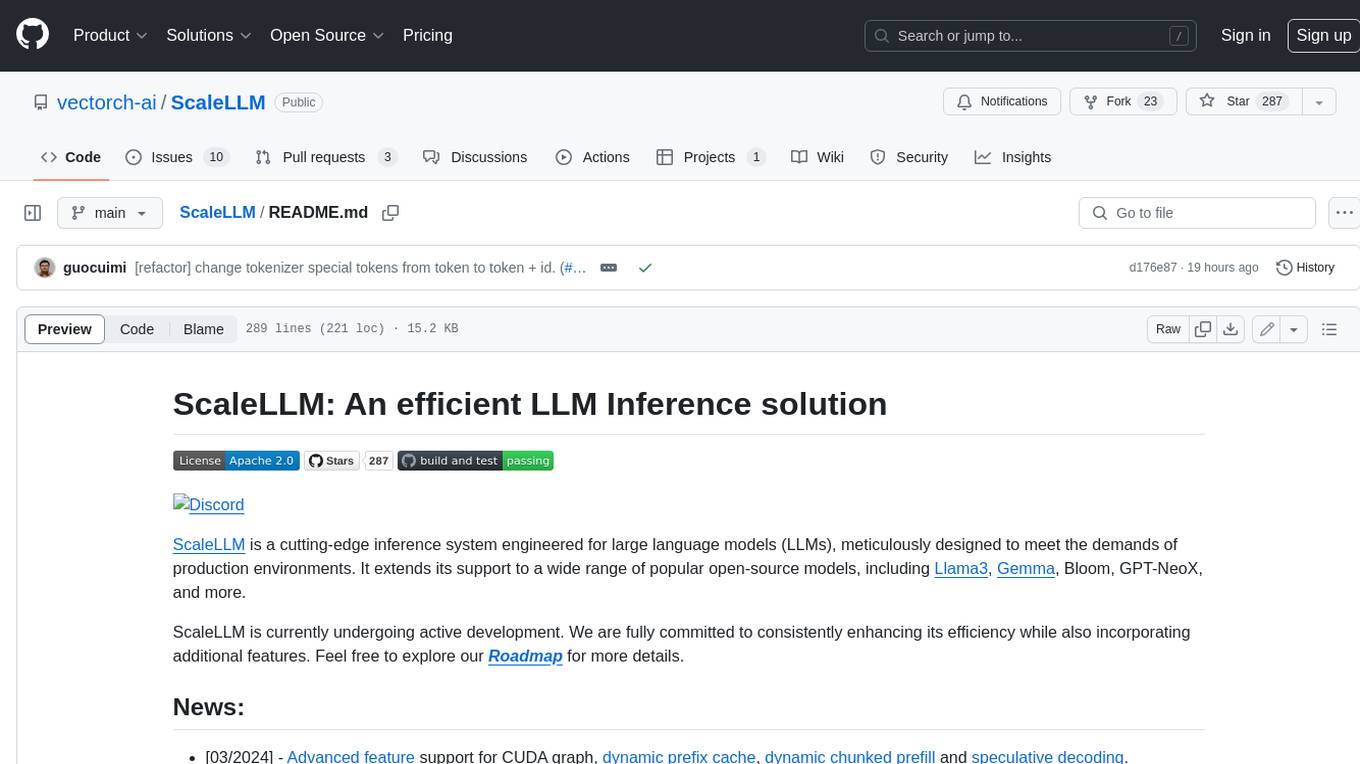
ScaleLLM
ScaleLLM is a cutting-edge inference system engineered for large language models (LLMs), meticulously designed to meet the demands of production environments. It extends its support to a wide range of popular open-source models, including Llama3, Gemma, Bloom, GPT-NeoX, and more. ScaleLLM is currently undergoing active development. We are fully committed to consistently enhancing its efficiency while also incorporating additional features. Feel free to explore our **_Roadmap_** for more details. ## Key Features * High Efficiency: Excels in high-performance LLM inference, leveraging state-of-the-art techniques and technologies like Flash Attention, Paged Attention, Continuous batching, and more. * Tensor Parallelism: Utilizes tensor parallelism for efficient model execution. * OpenAI-compatible API: An efficient golang rest api server that compatible with OpenAI. * Huggingface models: Seamless integration with most popular HF models, supporting safetensors. * Customizable: Offers flexibility for customization to meet your specific needs, and provides an easy way to add new models. * Production Ready: Engineered with production environments in mind, ScaleLLM is equipped with robust system monitoring and management features to ensure a seamless deployment experience.
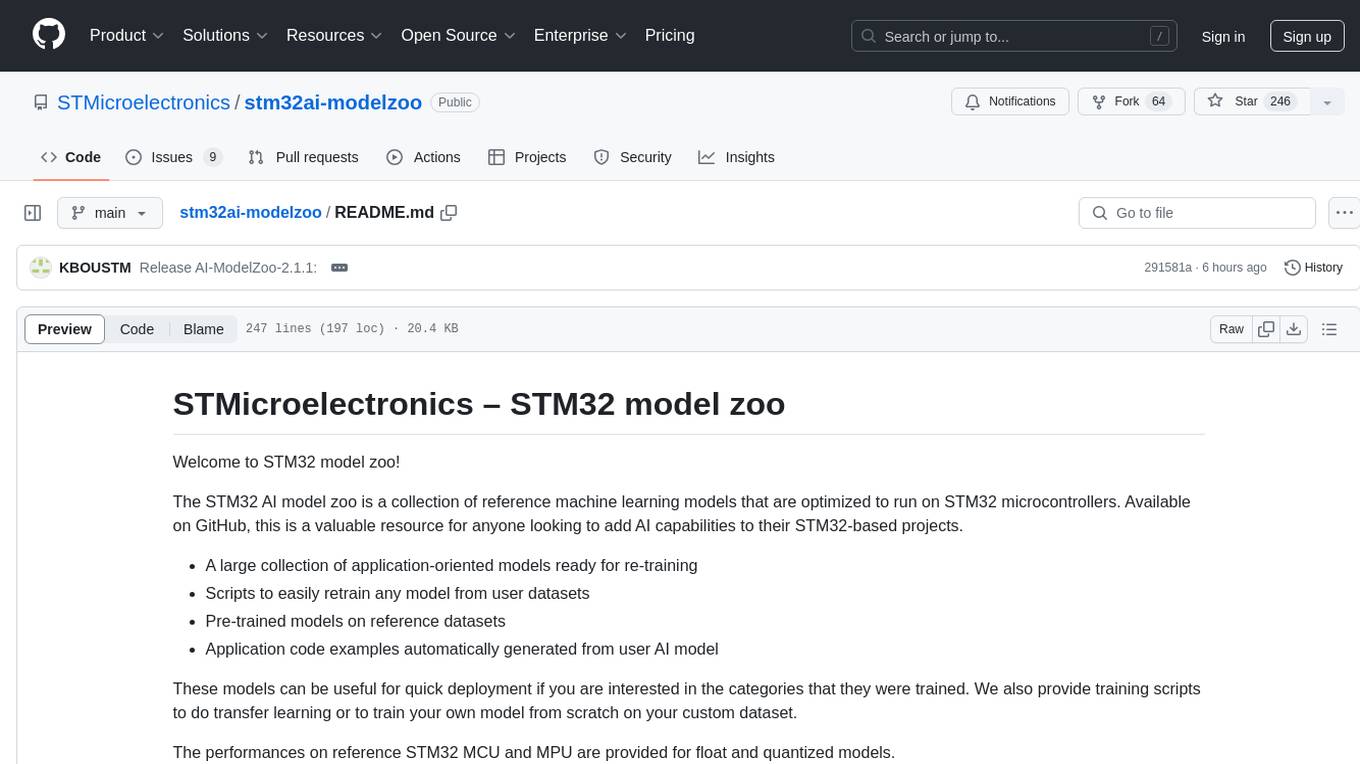
stm32ai-modelzoo
The STM32 AI model zoo is a collection of reference machine learning models optimized to run on STM32 microcontrollers. It provides a large collection of application-oriented models ready for re-training, scripts for easy retraining from user datasets, pre-trained models on reference datasets, and application code examples generated from user AI models. The project offers training scripts for transfer learning or training custom models from scratch. It includes performances on reference STM32 MCU and MPU for float and quantized models. The project is organized by application, providing step-by-step guides for training and deploying models.
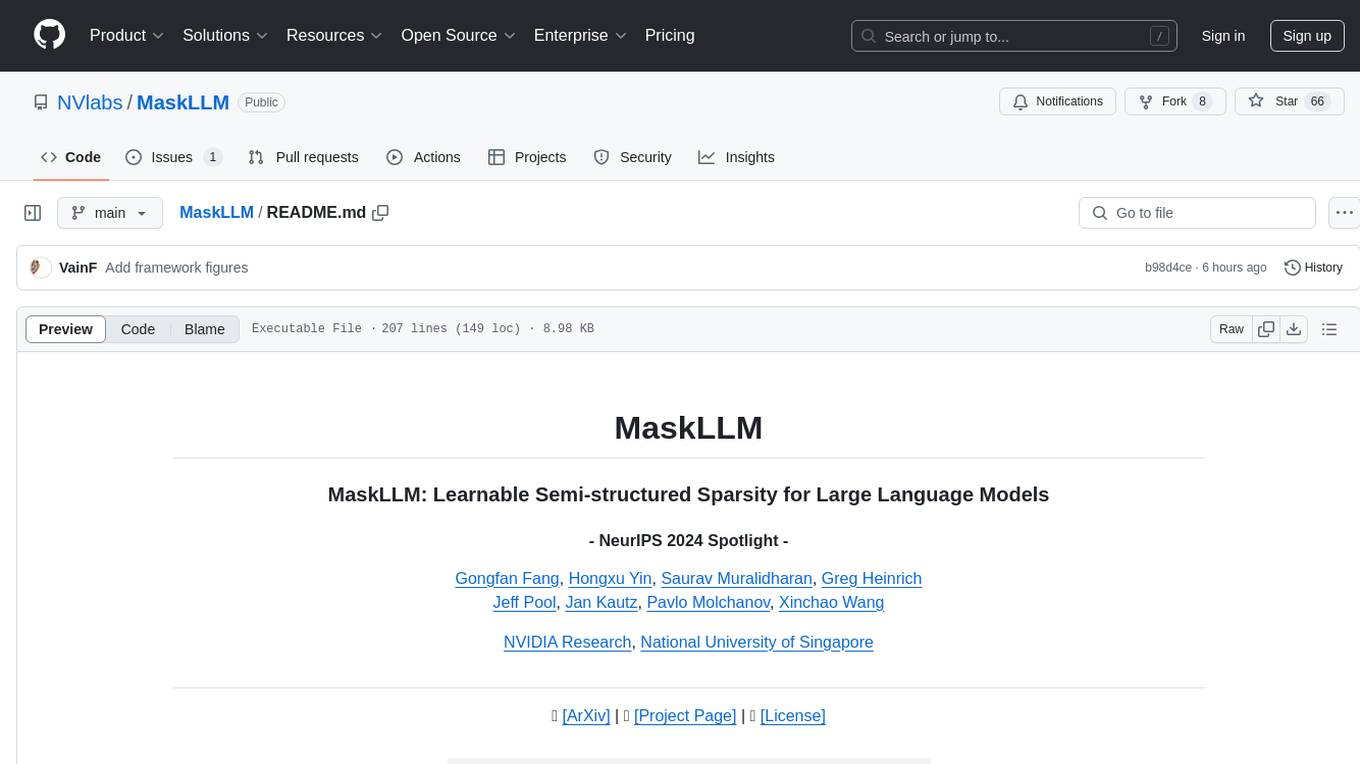
MaskLLM
MaskLLM is a learnable pruning method that establishes Semi-structured Sparsity in Large Language Models (LLMs) to reduce computational overhead during inference. It is scalable and benefits from larger training datasets. The tool provides examples for running MaskLLM with Megatron-LM, preparing LLaMA checkpoints, pre-tokenizing C4 data for Megatron, generating prior masks, training MaskLLM, and evaluating the model. It also includes instructions for exporting sparse models to Huggingface.
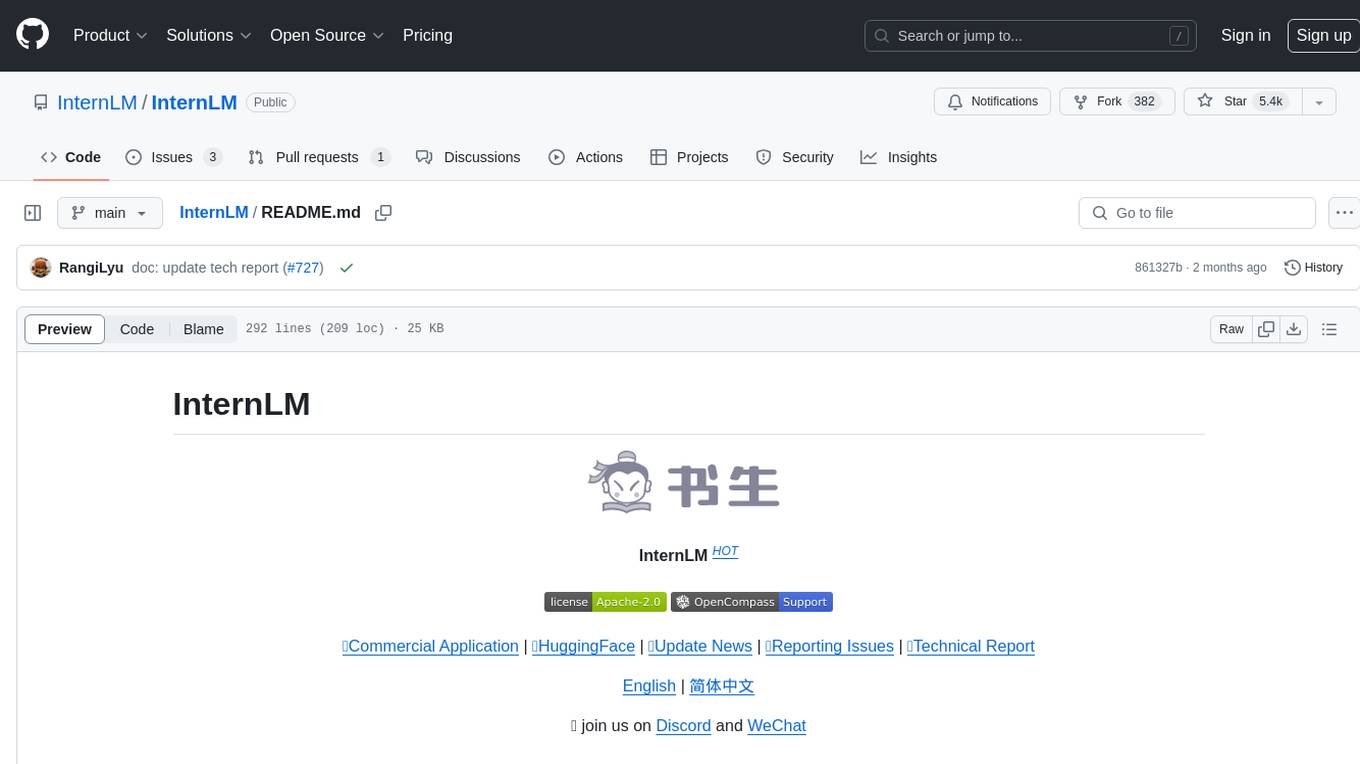
InternLM
InternLM is a powerful language model series with features such as 200K context window for long-context tasks, outstanding comprehensive performance in reasoning, math, code, chat experience, instruction following, and creative writing, code interpreter & data analysis capabilities, and stronger tool utilization capabilities. It offers models in sizes of 7B and 20B, suitable for research and complex scenarios. The models are recommended for various applications and exhibit better performance than previous generations. InternLM models may match or surpass other open-source models like ChatGPT. The tool has been evaluated on various datasets and has shown superior performance in multiple tasks. It requires Python >= 3.8, PyTorch >= 1.12.0, and Transformers >= 4.34 for usage. InternLM can be used for tasks like chat, agent applications, fine-tuning, deployment, and long-context inference.
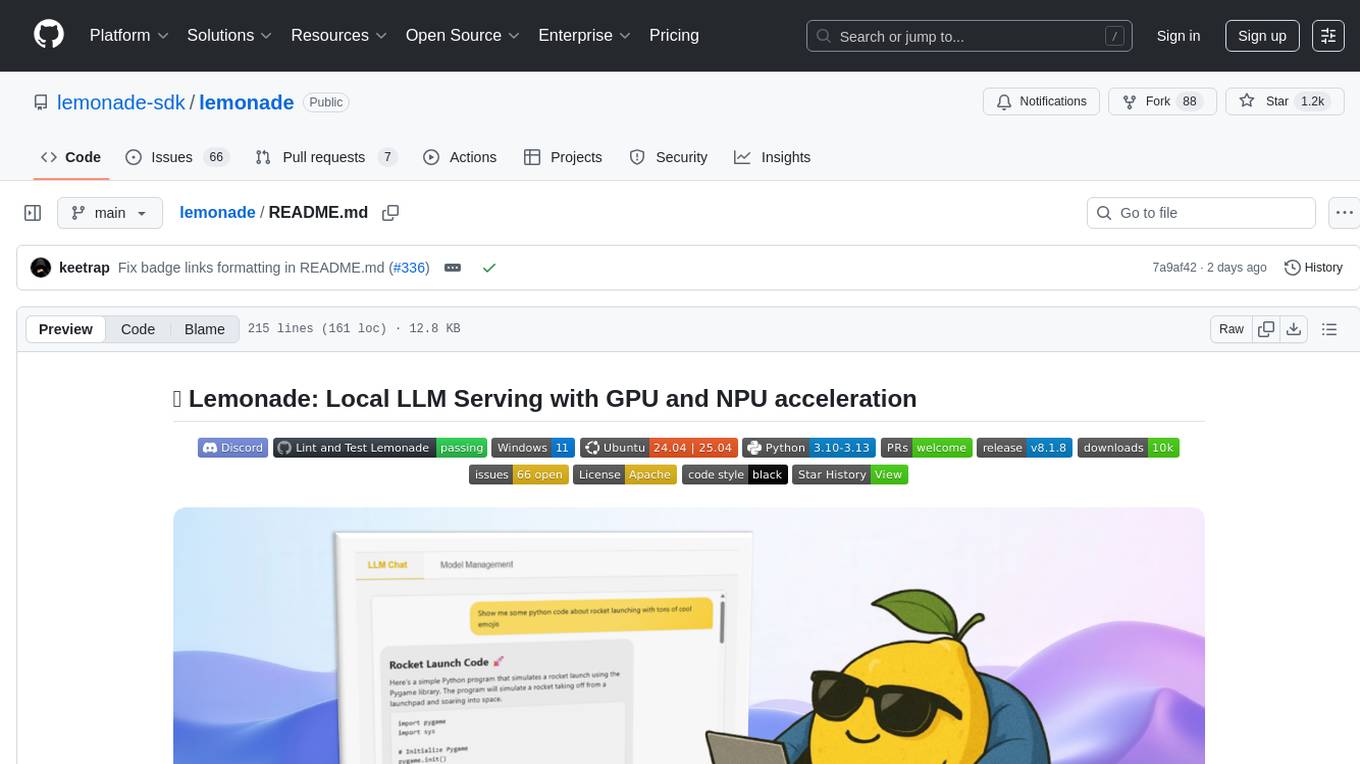
lemonade
Lemonade is a tool that helps users run local Large Language Models (LLMs) with high performance by configuring state-of-the-art inference engines for their Neural Processing Units (NPUs) and Graphics Processing Units (GPUs). It is used by startups, research teams, and large companies to run LLMs efficiently. Lemonade provides a high-level Python API for direct integration of LLMs into Python applications and a CLI for mixing and matching LLMs with various features like prompting templates, accuracy testing, performance benchmarking, and memory profiling. The tool supports both GGUF and ONNX models and allows importing custom models from Hugging Face using the Model Manager. Lemonade is designed to be easy to use and switch between different configurations at runtime, making it a versatile tool for running LLMs locally.
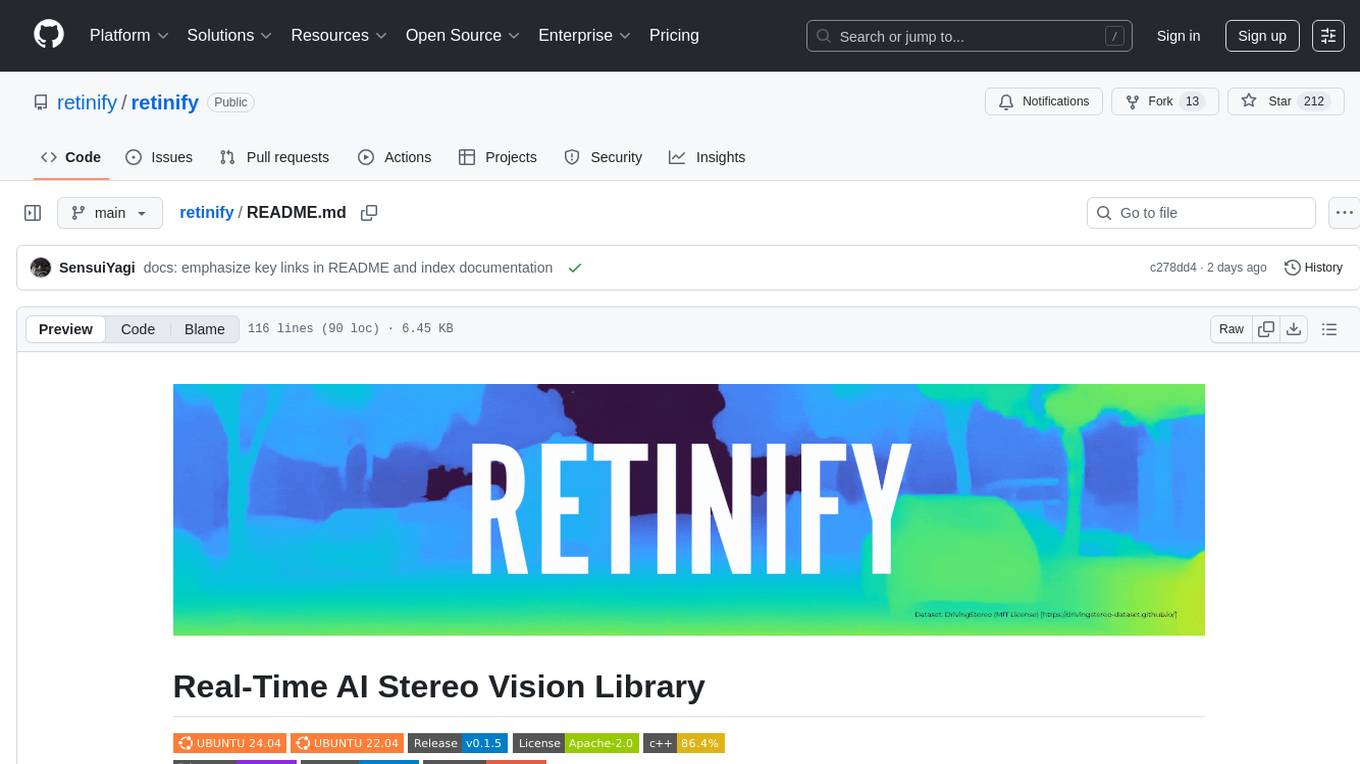
retinify
Retinify is an advanced AI-powered stereo vision library designed for robotics, enabling real-time, high-precision 3D perception by leveraging GPU and NPU acceleration. It is open source under Apache-2.0 license, offers high precision 3D mapping and object recognition, runs computations on GPU for fast performance, accepts stereo images from any rectified camera setup, is cost-efficient using minimal hardware, and has minimal dependencies on CUDA Toolkit, cuDNN, and TensorRT. The tool provides a pipeline for stereo matching and supports various image data types independently of OpenCV.

TTS-WebUI
TTS WebUI is a comprehensive tool for text-to-speech synthesis, audio/music generation, and audio conversion. It offers a user-friendly interface for various AI projects related to voice and audio processing. The tool provides a range of models and extensions for different tasks, along with integrations like Silly Tavern and OpenWebUI. With support for Docker setup and compatibility with Linux and Windows, TTS WebUI aims to facilitate creative and responsible use of AI technologies in a user-friendly manner.
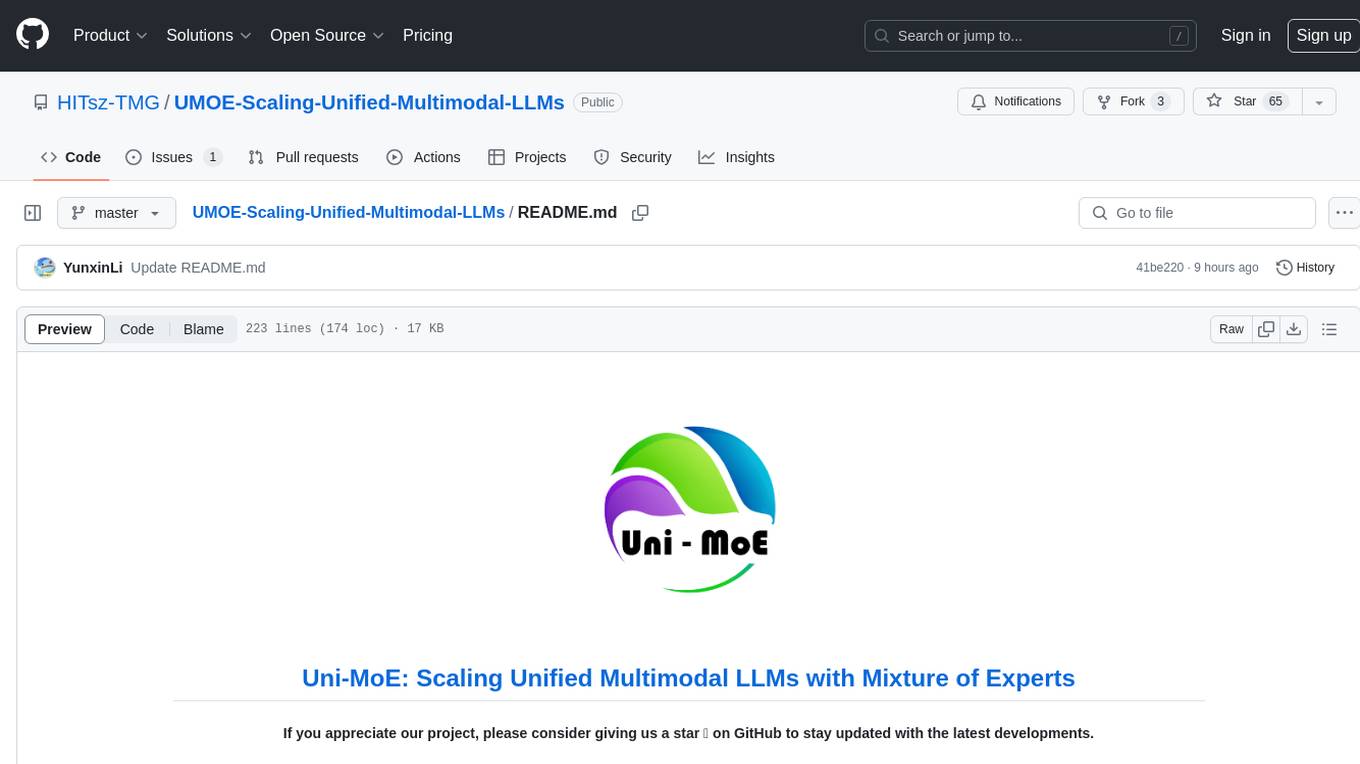
UMOE-Scaling-Unified-Multimodal-LLMs
Uni-MoE is a MoE-based unified multimodal model that can handle diverse modalities including audio, speech, image, text, and video. The project focuses on scaling Unified Multimodal LLMs with a Mixture of Experts framework. It offers enhanced functionality for training across multiple nodes and GPUs, as well as parallel processing at both the expert and modality levels. The model architecture involves three training stages: building connectors for multimodal understanding, developing modality-specific experts, and incorporating multiple trained experts into LLMs using the LoRA technique on mixed multimodal data. The tool provides instructions for installation, weights organization, inference, training, and evaluation on various datasets.
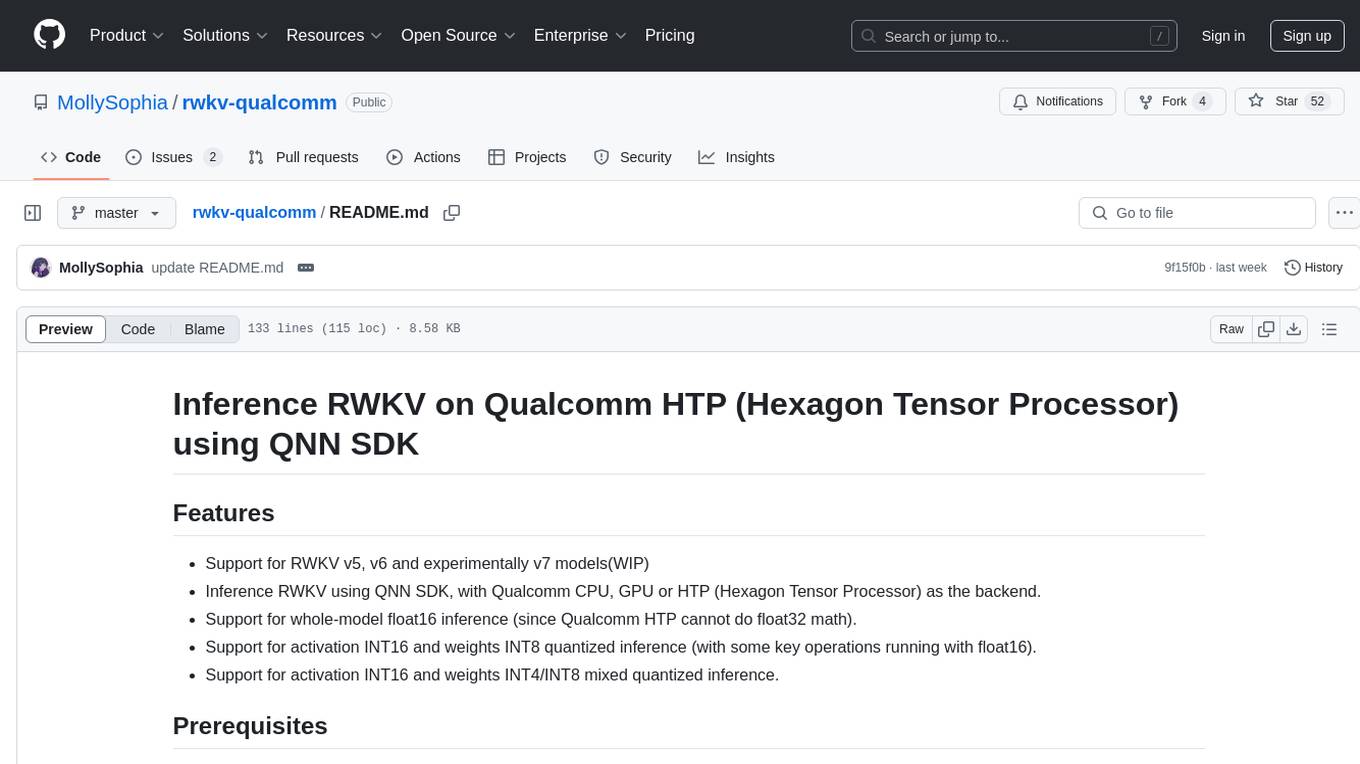
rwkv-qualcomm
This repository provides support for inference RWKV models on Qualcomm HTP (Hexagon Tensor Processor) using QNN SDK. It supports RWKV v5, v6, and experimentally v7 models, inference using Qualcomm CPU, GPU, or HTP as the backend, whole-model float16 inference, activation INT16 and weights INT8 quantized inference, and activation INT16 and weights INT4/INT8 mixed quantized inference. Users can convert model weights to QNN model library files, generate HTP context cache, and run inference on Qualcomm Snapdragon SM8650 with HTP v75. The project requires QNN SDK, AIMET toolkit, and specific hardware for verification.
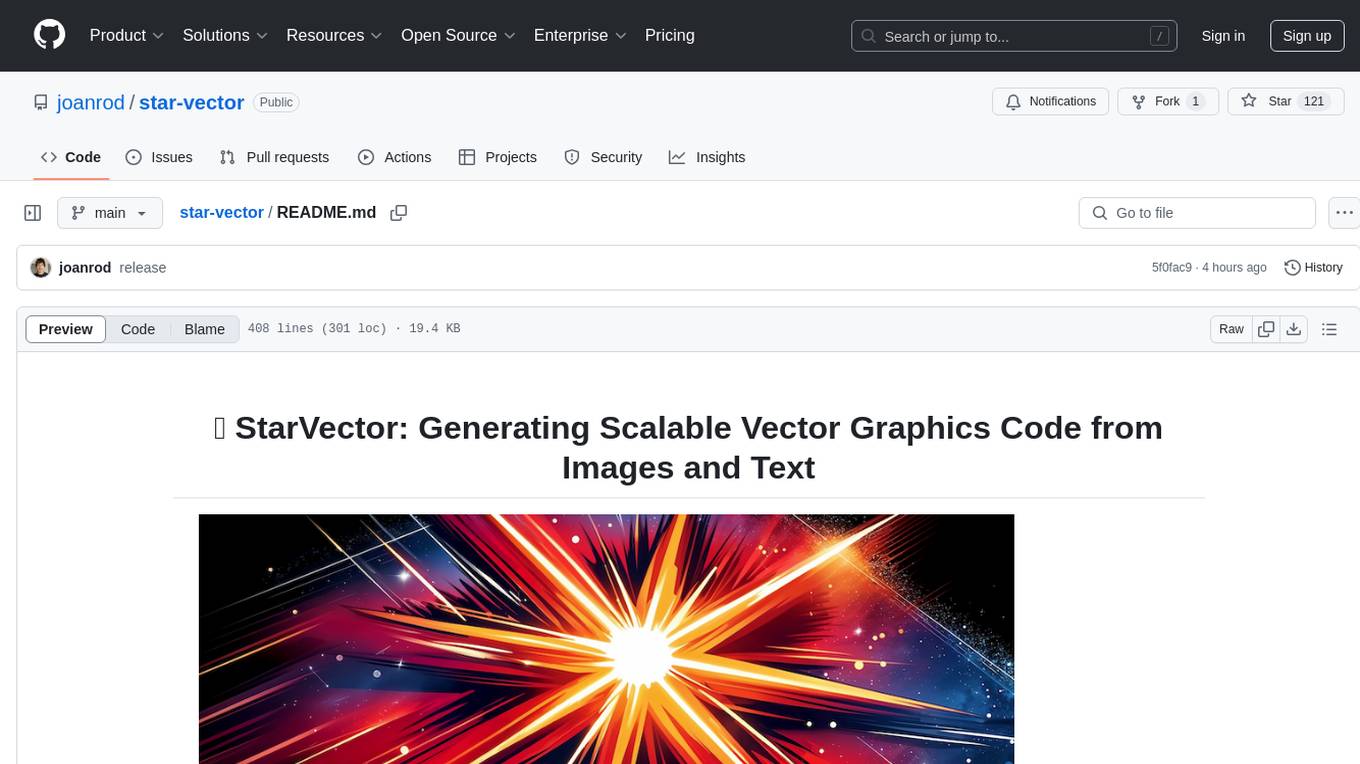
star-vector
StarVector is a multimodal vision-language model for Scalable Vector Graphics (SVG) generation. It can be used to perform image2SVG and text2SVG generation. StarVector works directly in the SVG code space, leveraging visual understanding to apply accurate SVG primitives. It achieves state-of-the-art performance in producing compact and semantically rich SVGs. The tool provides Hugging Face model checkpoints for image2SVG vectorization, with models like StarVector-8B and StarVector-1B. It also offers datasets like SVG-Stack, SVG-Fonts, SVG-Icons, SVG-Emoji, and SVG-Diagrams for evaluation. StarVector can be trained using Deepspeed or FSDP for tasks like Image2SVG and Text2SVG generation. The tool provides a demo with options for HuggingFace generation or VLLM backend for faster generation speed.
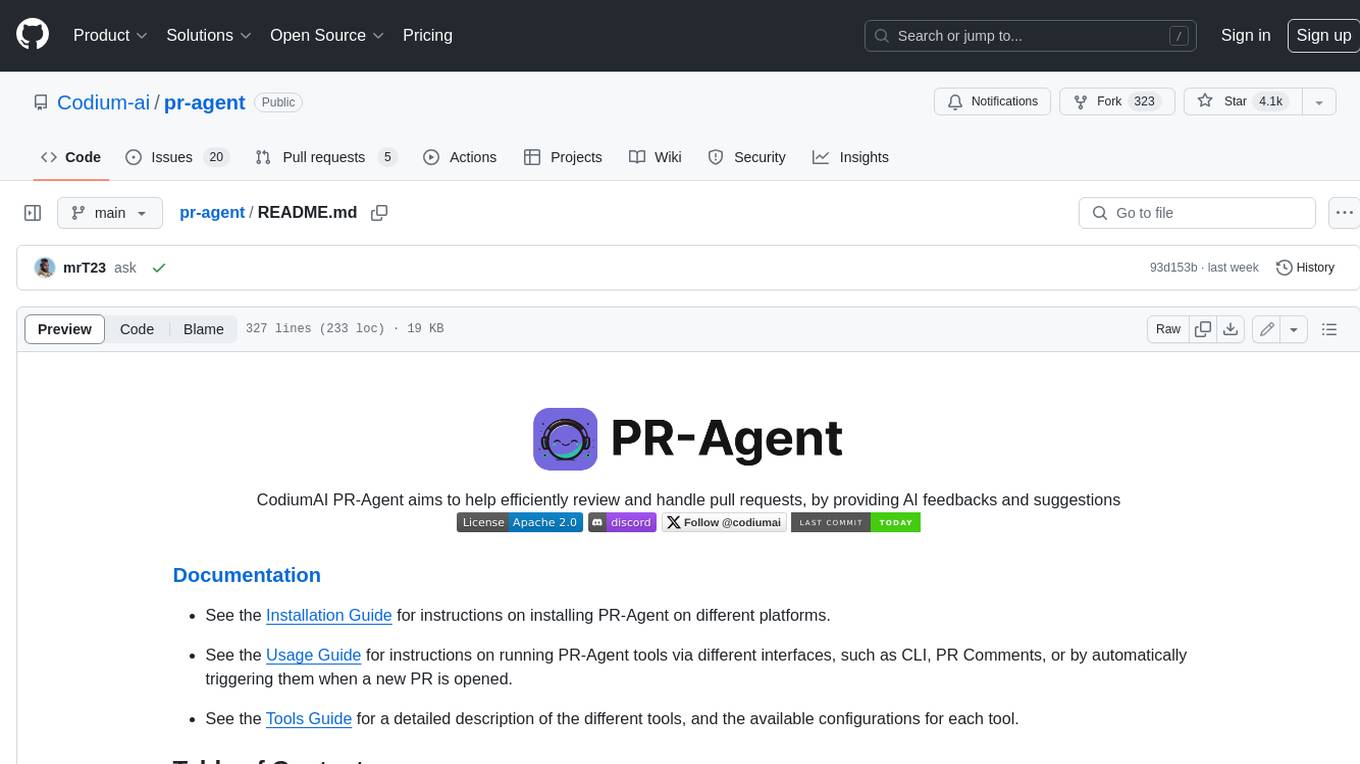
pr-agent
PR-Agent is a tool that helps to efficiently review and handle pull requests by providing AI feedbacks and suggestions. It supports various commands such as generating PR descriptions, providing code suggestions, answering questions about the PR, and updating the CHANGELOG.md file. PR-Agent can be used via CLI, GitHub Action, GitHub App, Docker, and supports multiple git providers and models. It emphasizes real-life practical usage, with each tool having a single GPT-4 call for quick and affordable responses. The PR Compression strategy enables effective handling of both short and long PRs, while the JSON prompting strategy allows for modular and customizable tools. PR-Agent Pro, the hosted version by CodiumAI, provides additional benefits such as full management, improved privacy, priority support, and extra features.
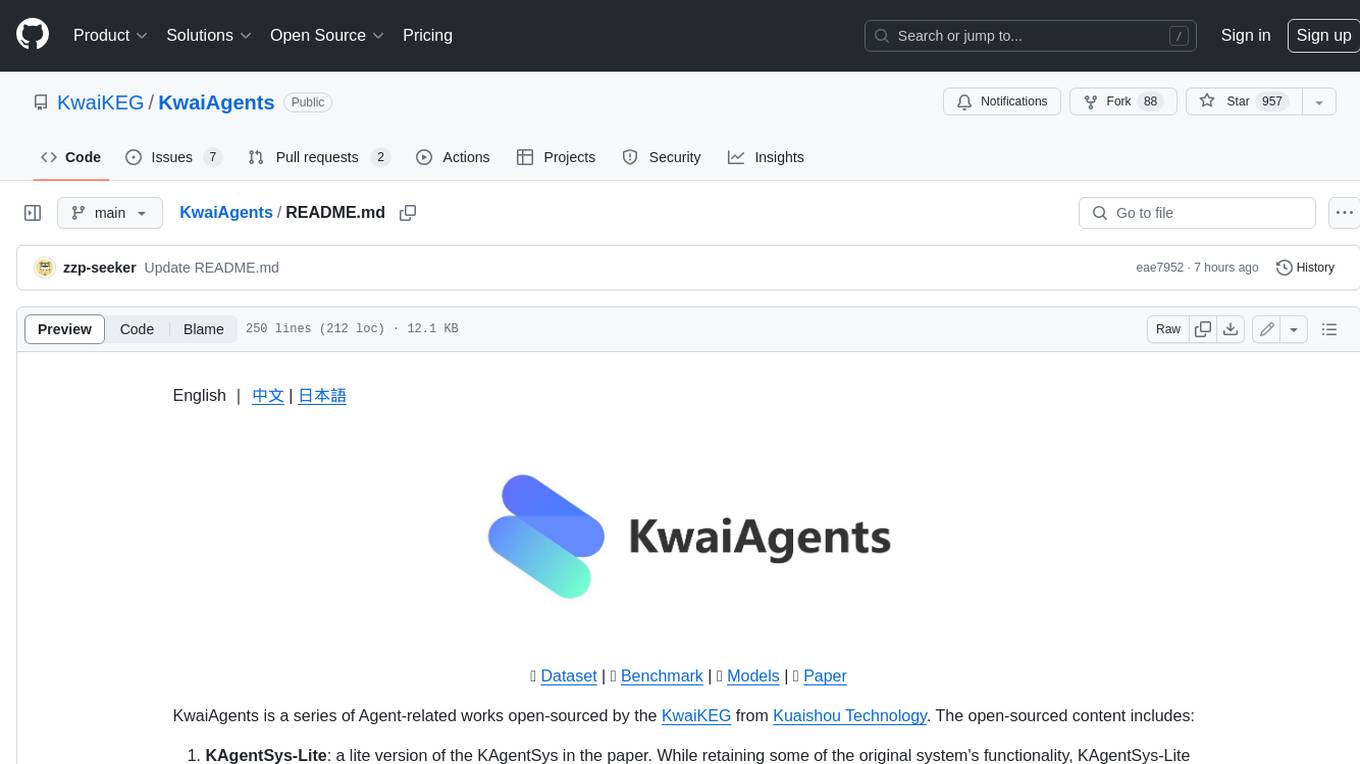
KwaiAgents
KwaiAgents is a series of Agent-related works open-sourced by the [KwaiKEG](https://github.com/KwaiKEG) from [Kuaishou Technology](https://www.kuaishou.com/en). The open-sourced content includes: 1. **KAgentSys-Lite**: a lite version of the KAgentSys in the paper. While retaining some of the original system's functionality, KAgentSys-Lite has certain differences and limitations when compared to its full-featured counterpart, such as: (1) a more limited set of tools; (2) a lack of memory mechanisms; (3) slightly reduced performance capabilities; and (4) a different codebase, as it evolves from open-source projects like BabyAGI and Auto-GPT. Despite these modifications, KAgentSys-Lite still delivers comparable performance among numerous open-source Agent systems available. 2. **KAgentLMs**: a series of large language models with agent capabilities such as planning, reflection, and tool-use, acquired through the Meta-agent tuning proposed in the paper. 3. **KAgentInstruct**: over 200k Agent-related instructions finetuning data (partially human-edited) proposed in the paper. 4. **KAgentBench**: over 3,000 human-edited, automated evaluation data for testing Agent capabilities, with evaluation dimensions including planning, tool-use, reflection, concluding, and profiling.
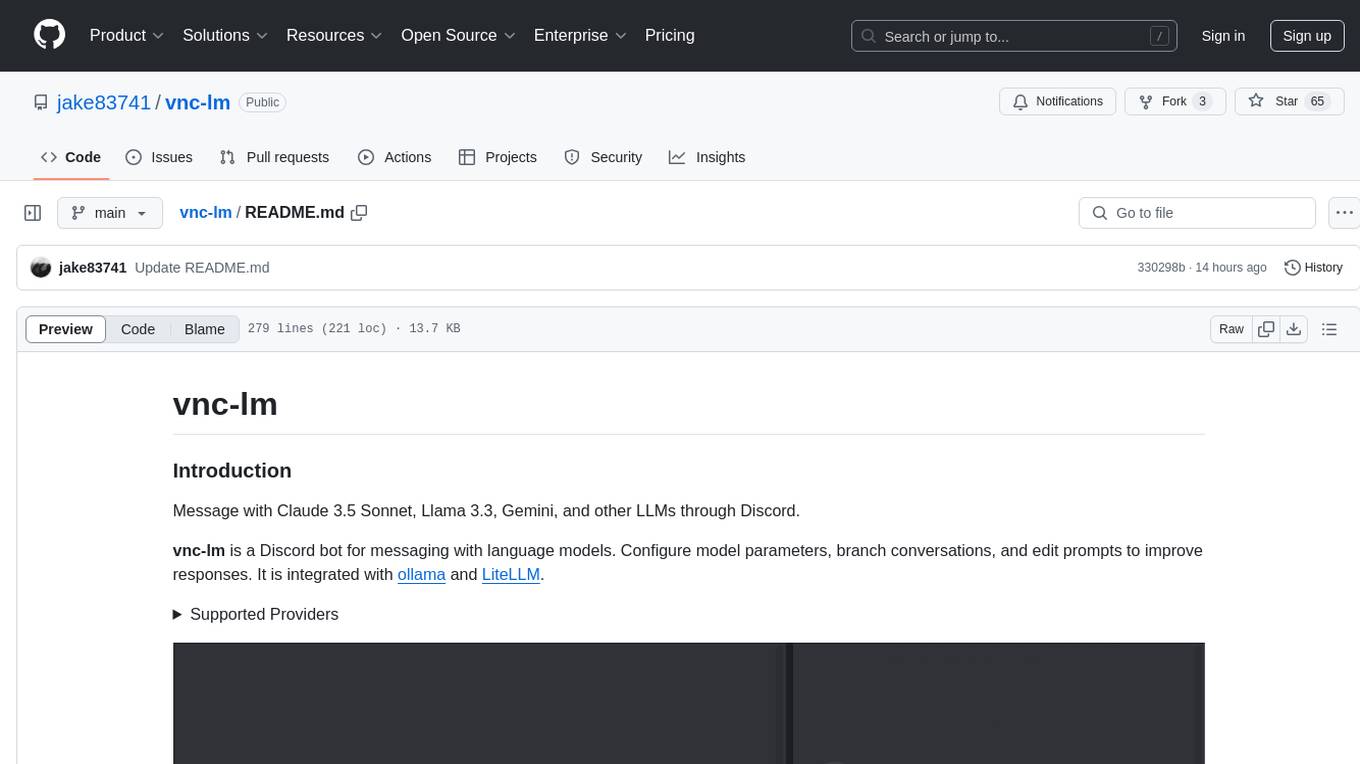
vnc-lm
vnc-lm is a Discord bot designed for messaging with language models. Users can configure model parameters, branch conversations, and edit prompts to enhance responses. The bot supports various providers like OpenAI, Huggingface, and Cloudflare Workers AI. It integrates with ollama and LiteLLM, allowing users to access a wide range of language model APIs through a single interface. Users can manage models, switch between models, split long messages, and create conversation branches. LiteLLM integration enables support for OpenAI-compatible APIs and local LLM services. The bot requires Docker for installation and can be configured through environment variables. Troubleshooting tips are provided for common issues like context window problems, Discord API errors, and LiteLLM issues.
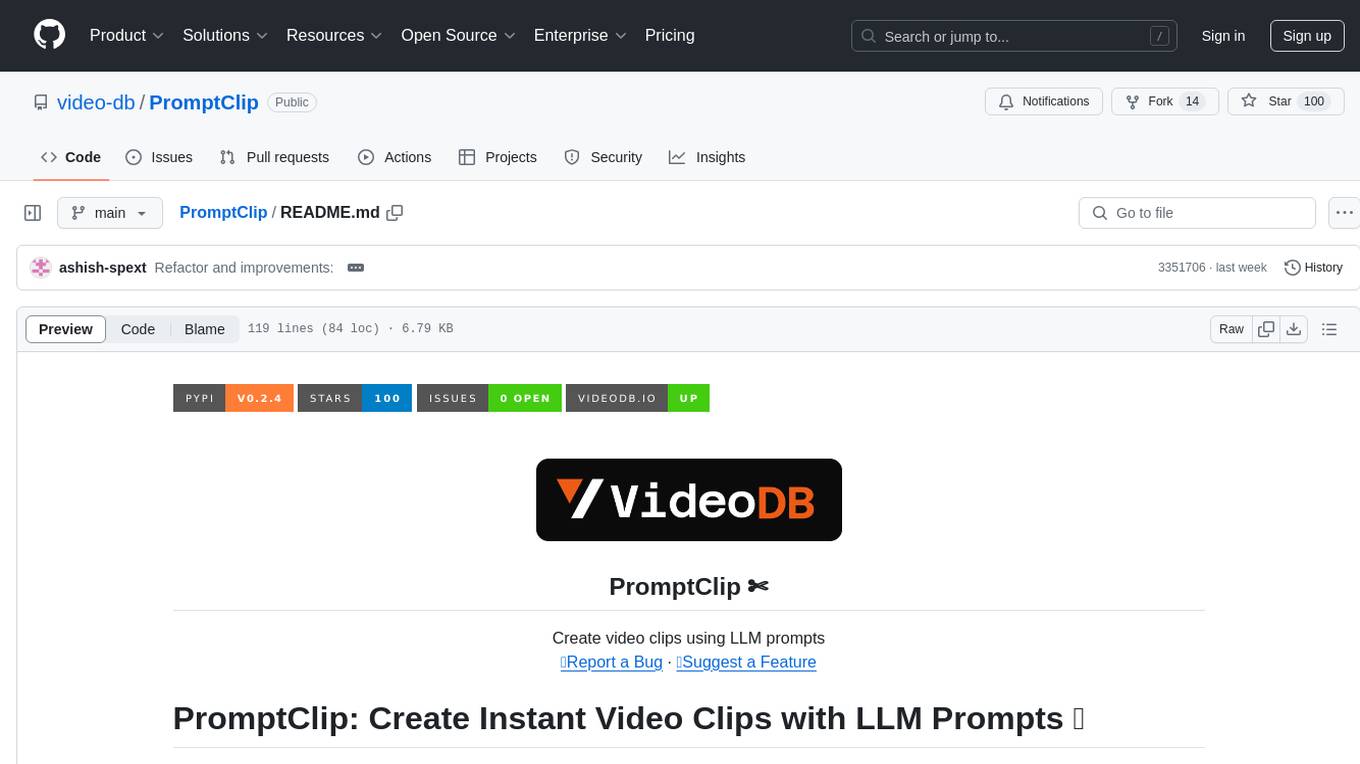
PromptClip
PromptClip is a tool that allows developers to create video clips using LLM prompts. Users can upload videos from various sources, prompt the video in natural language, use different LLM models, instantly watch the generated clips, finetune the clips, and add music or image overlays. The tool provides a seamless way to extract specific moments from videos based on user queries, making video editing and content creation more efficient and intuitive.
For similar tasks
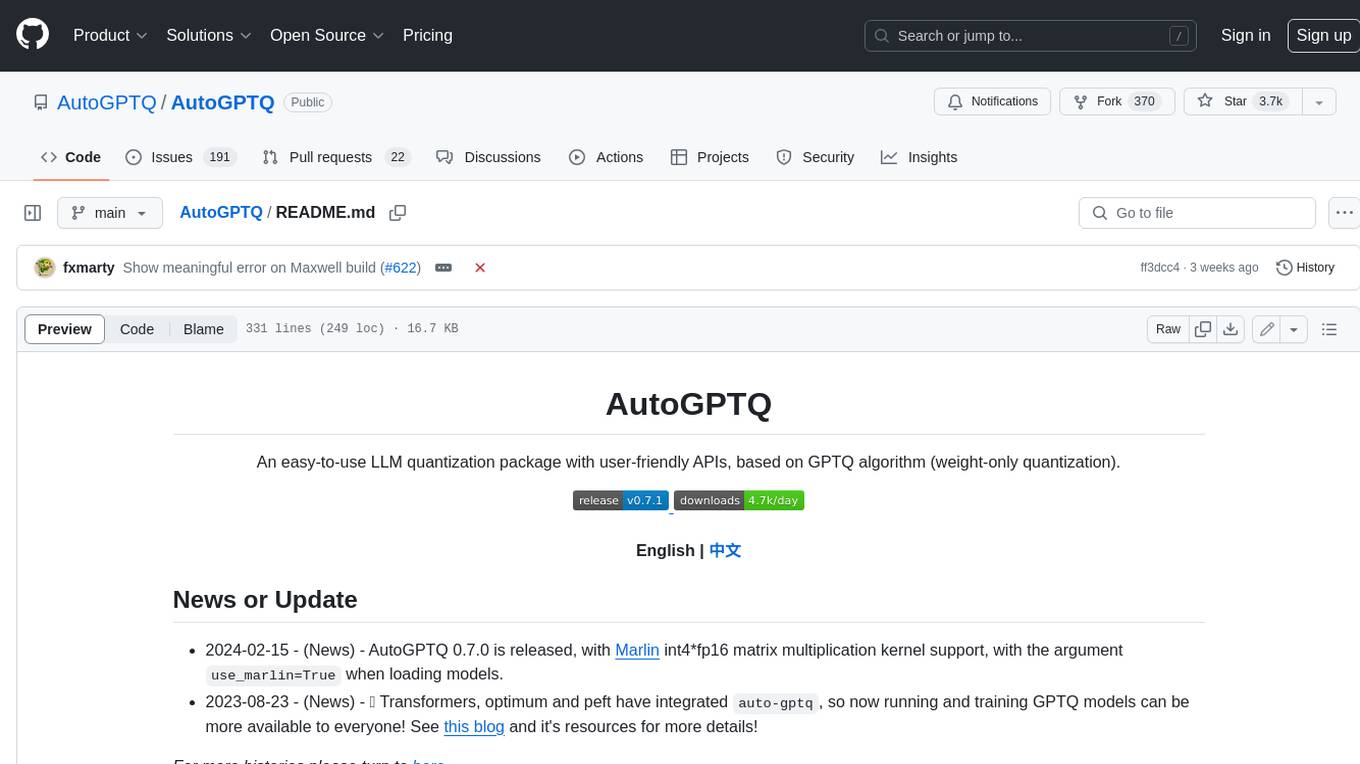
AutoGPTQ
AutoGPTQ is an easy-to-use LLM quantization package with user-friendly APIs, based on GPTQ algorithm (weight-only quantization). It provides a simple and efficient way to quantize large language models (LLMs) to reduce their size and computational cost while maintaining their performance. AutoGPTQ supports a wide range of LLM models, including GPT-2, GPT-J, OPT, and BLOOM. It also supports various evaluation tasks, such as language modeling, sequence classification, and text summarization. With AutoGPTQ, users can easily quantize their LLM models and deploy them on resource-constrained devices, such as mobile phones and embedded systems.
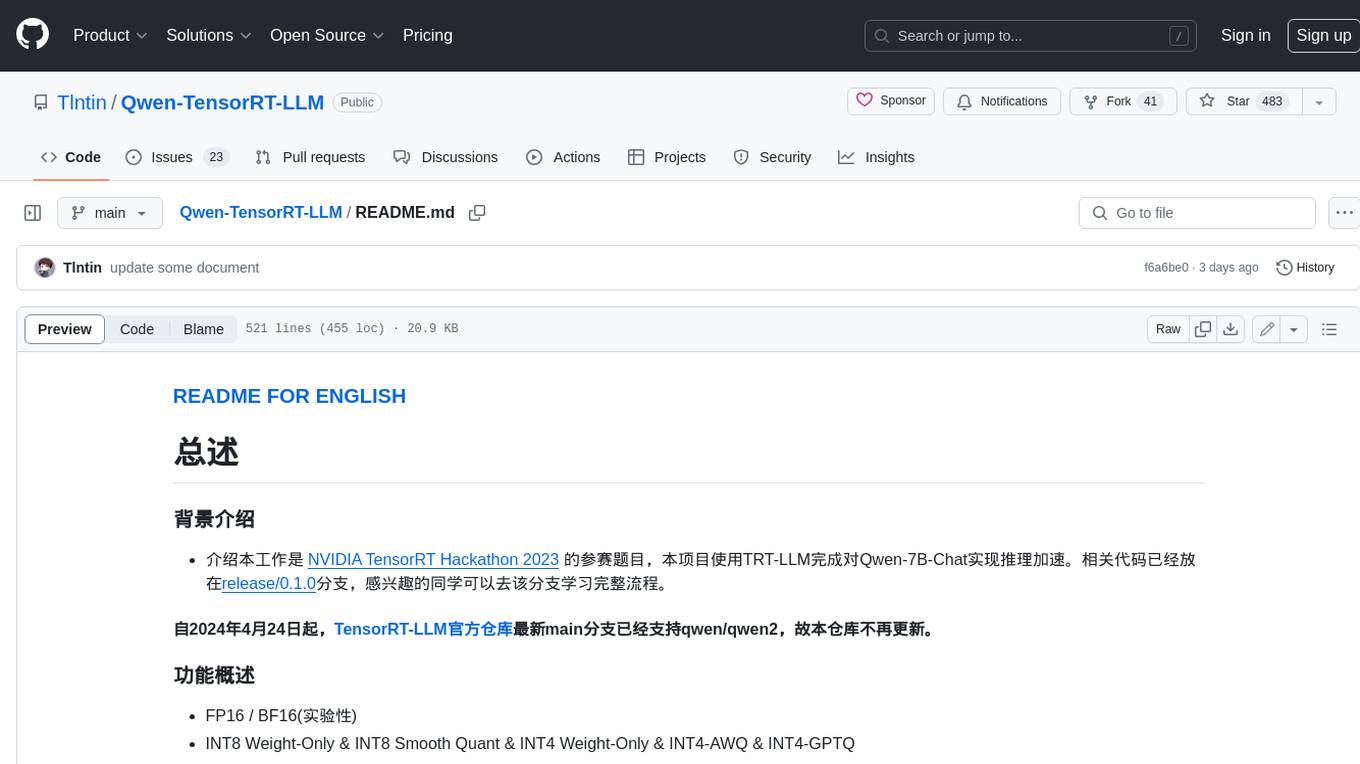
Qwen-TensorRT-LLM
Qwen-TensorRT-LLM is a project developed for the NVIDIA TensorRT Hackathon 2023, focusing on accelerating inference for the Qwen-7B-Chat model using TRT-LLM. The project offers various functionalities such as FP16/BF16 support, INT8 and INT4 quantization options, Tensor Parallel for multi-GPU parallelism, web demo setup with gradio, Triton API deployment for maximum throughput/concurrency, fastapi integration for openai requests, CLI interaction, and langchain support. It supports models like qwen2, qwen, and qwen-vl for both base and chat models. The project also provides tutorials on Bilibili and blogs for adapting Qwen models in NVIDIA TensorRT-LLM, along with hardware requirements and quick start guides for different model types and quantization methods.
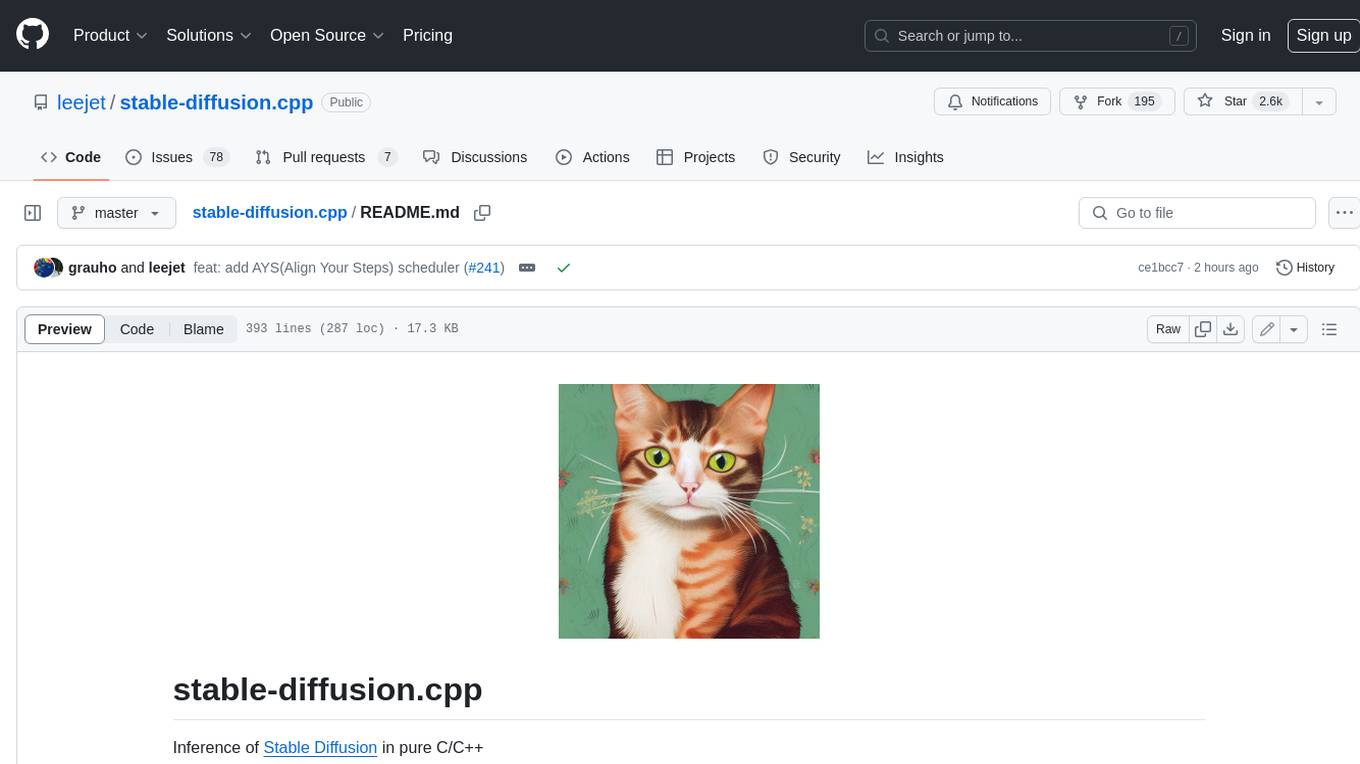
stable-diffusion.cpp
The stable-diffusion.cpp repository provides an implementation for inferring stable diffusion in pure C/C++. It offers features such as support for different versions of stable diffusion, lightweight and dependency-free implementation, various quantization support, memory-efficient CPU inference, GPU acceleration, and more. Users can download the built executable program or build it manually. The repository also includes instructions for downloading weights, building from scratch, using different acceleration methods, running the tool, converting weights, and utilizing various features like Flash Attention, ESRGAN upscaling, PhotoMaker support, and more. Additionally, it mentions future TODOs and provides information on memory requirements, bindings, UIs, contributors, and references.

LMOps
LMOps is a research initiative focusing on fundamental research and technology for building AI products with foundation models, particularly enabling AI capabilities with Large Language Models (LLMs) and Generative AI models. The project explores various aspects such as prompt optimization, longer context handling, LLM alignment, acceleration of LLMs, LLM customization, and understanding in-context learning. It also includes tools like Promptist for automatic prompt optimization, Structured Prompting for efficient long-sequence prompts consumption, and X-Prompt for extensible prompts beyond natural language. Additionally, LLMA accelerators are developed to speed up LLM inference by referencing and copying text spans from documents. The project aims to advance technologies that facilitate prompting language models and enhance the performance of LLMs in various scenarios.
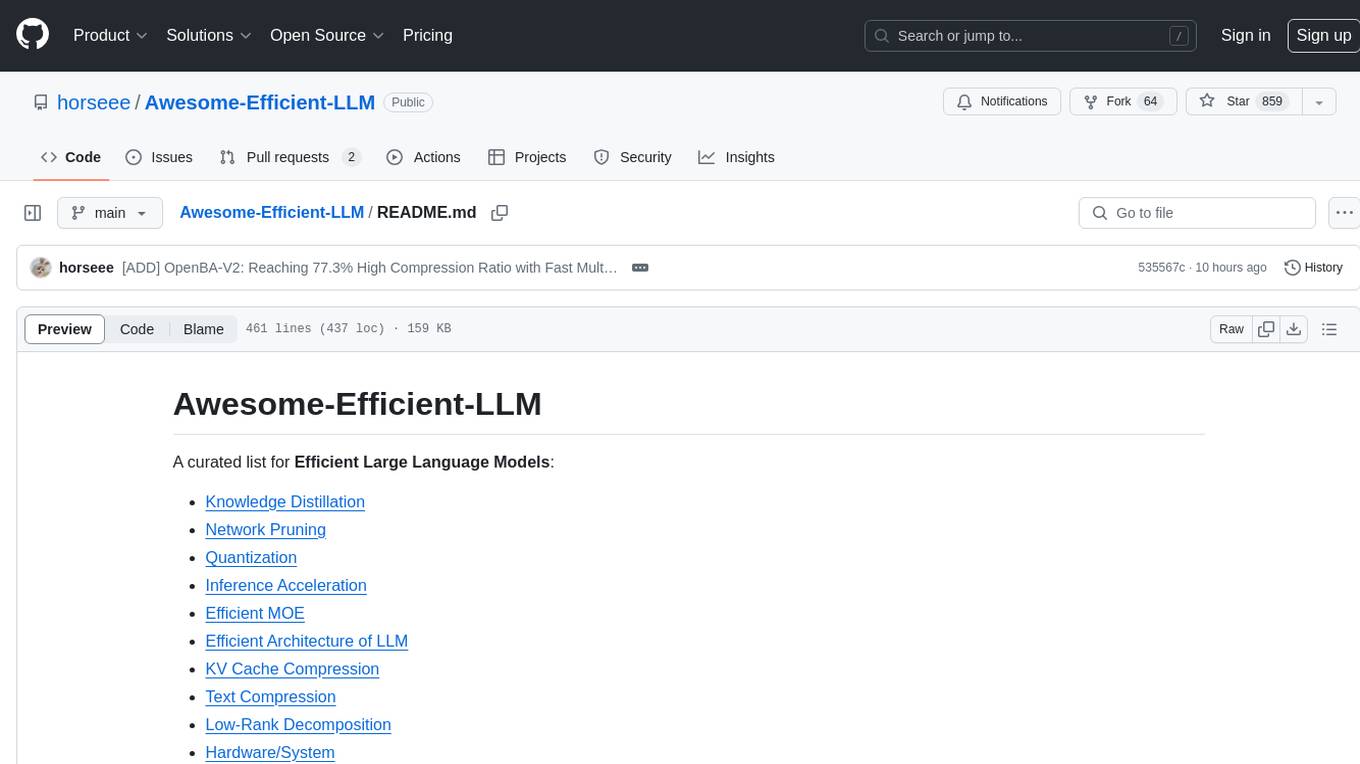
Awesome-Efficient-LLM
Awesome-Efficient-LLM is a curated list focusing on efficient large language models. It includes topics such as knowledge distillation, network pruning, quantization, inference acceleration, efficient MOE, efficient architecture of LLM, KV cache compression, text compression, low-rank decomposition, hardware/system, tuning, and survey. The repository provides a collection of papers and projects related to improving the efficiency of large language models through various techniques like sparsity, quantization, and compression.
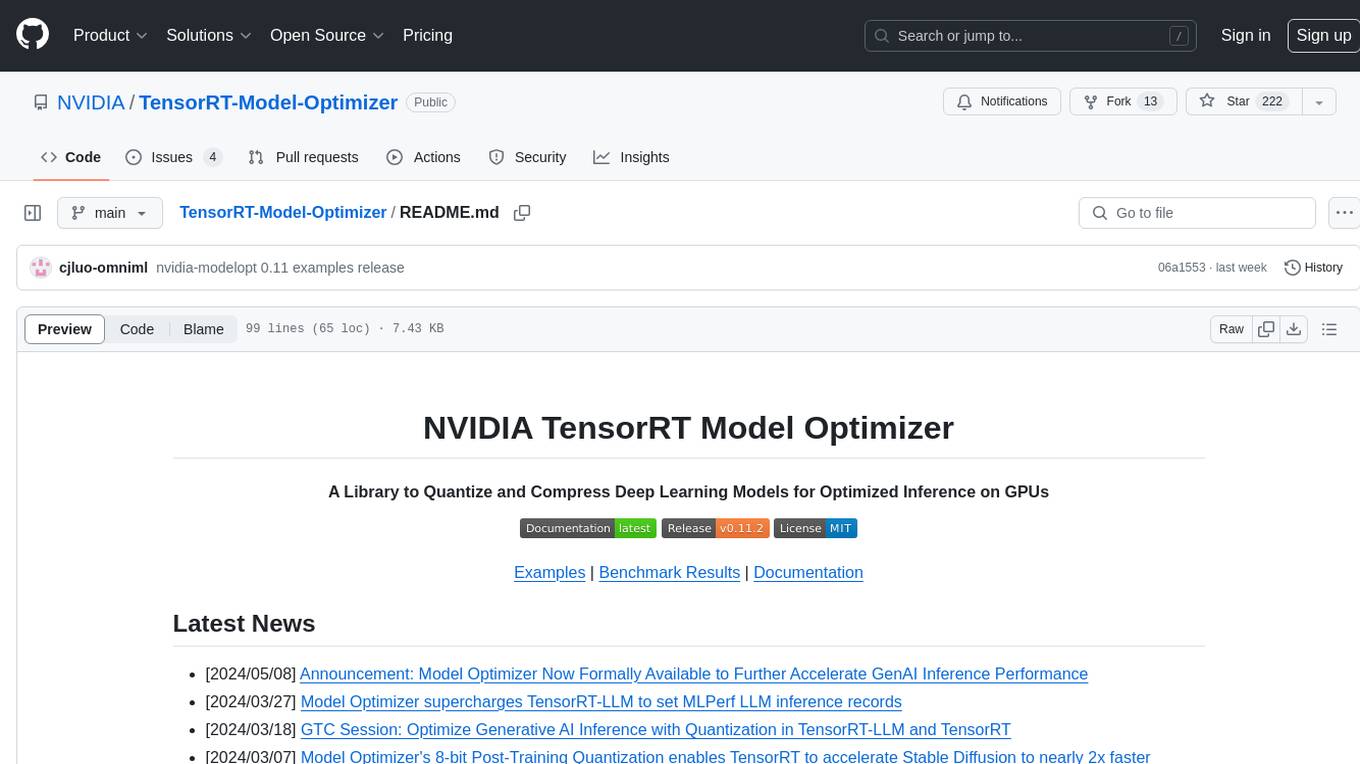
TensorRT-Model-Optimizer
The NVIDIA TensorRT Model Optimizer is a library designed to quantize and compress deep learning models for optimized inference on GPUs. It offers state-of-the-art model optimization techniques including quantization and sparsity to reduce inference costs for generative AI models. Users can easily stack different optimization techniques to produce quantized checkpoints from torch or ONNX models. The quantized checkpoints are ready for deployment in inference frameworks like TensorRT-LLM or TensorRT, with planned integrations for NVIDIA NeMo and Megatron-LM. The tool also supports 8-bit quantization with Stable Diffusion for enterprise users on NVIDIA NIM. Model Optimizer is available for free on NVIDIA PyPI, and this repository serves as a platform for sharing examples, GPU-optimized recipes, and collecting community feedback.
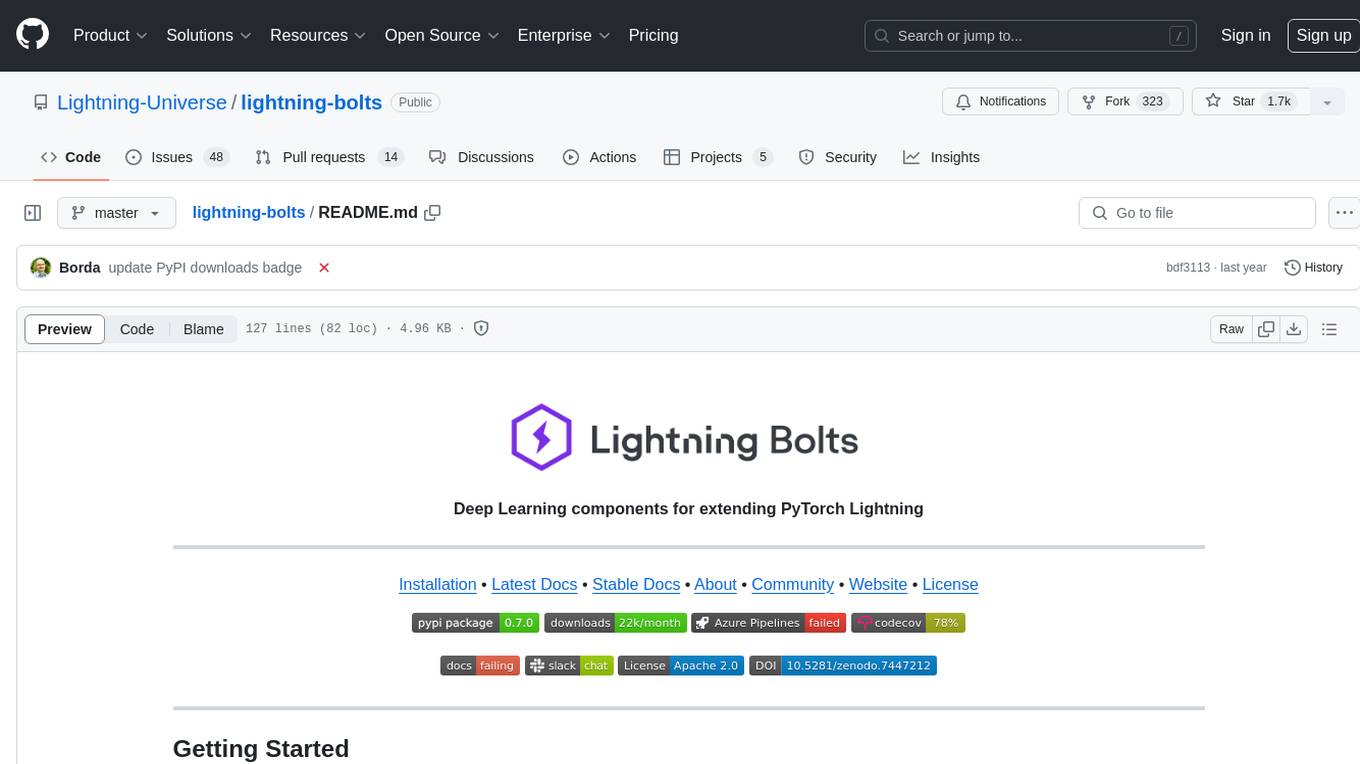
lightning-bolts
Bolts package provides a variety of components to extend PyTorch Lightning, such as callbacks & datasets, for applied research and production. Users can accelerate Lightning training with the Torch ORT Callback to optimize ONNX graph for faster training & inference. Additionally, users can introduce sparsity with the SparseMLCallback to accelerate inference by leveraging the DeepSparse engine. Specific research implementations are encouraged, with contributions that help train SSL models and integrate with Lightning Flash for state-of-the-art models in applied research.

ms-swift
ms-swift is an official framework provided by the ModelScope community for fine-tuning and deploying large language models and multi-modal large models. It supports training, inference, evaluation, quantization, and deployment of over 400 large models and 100+ multi-modal large models. The framework includes various training technologies and accelerates inference, evaluation, and deployment modules. It offers a Gradio-based Web-UI interface and best practices for easy application of large models. ms-swift supports a wide range of model types, dataset types, hardware support, lightweight training methods, distributed training techniques, quantization training, RLHF training, multi-modal training, interface training, plugin and extension support, inference acceleration engines, model evaluation, and model quantization.
For similar jobs

weave
Weave is a toolkit for developing Generative AI applications, built by Weights & Biases. With Weave, you can log and debug language model inputs, outputs, and traces; build rigorous, apples-to-apples evaluations for language model use cases; and organize all the information generated across the LLM workflow, from experimentation to evaluations to production. Weave aims to bring rigor, best-practices, and composability to the inherently experimental process of developing Generative AI software, without introducing cognitive overhead.

LLMStack
LLMStack is a no-code platform for building generative AI agents, workflows, and chatbots. It allows users to connect their own data, internal tools, and GPT-powered models without any coding experience. LLMStack can be deployed to the cloud or on-premise and can be accessed via HTTP API or triggered from Slack or Discord.

VisionCraft
The VisionCraft API is a free API for using over 100 different AI models. From images to sound.

kaito
Kaito is an operator that automates the AI/ML inference model deployment in a Kubernetes cluster. It manages large model files using container images, avoids tuning deployment parameters to fit GPU hardware by providing preset configurations, auto-provisions GPU nodes based on model requirements, and hosts large model images in the public Microsoft Container Registry (MCR) if the license allows. Using Kaito, the workflow of onboarding large AI inference models in Kubernetes is largely simplified.

PyRIT
PyRIT is an open access automation framework designed to empower security professionals and ML engineers to red team foundation models and their applications. It automates AI Red Teaming tasks to allow operators to focus on more complicated and time-consuming tasks and can also identify security harms such as misuse (e.g., malware generation, jailbreaking), and privacy harms (e.g., identity theft). The goal is to allow researchers to have a baseline of how well their model and entire inference pipeline is doing against different harm categories and to be able to compare that baseline to future iterations of their model. This allows them to have empirical data on how well their model is doing today, and detect any degradation of performance based on future improvements.

tabby
Tabby is a self-hosted AI coding assistant, offering an open-source and on-premises alternative to GitHub Copilot. It boasts several key features: * Self-contained, with no need for a DBMS or cloud service. * OpenAPI interface, easy to integrate with existing infrastructure (e.g Cloud IDE). * Supports consumer-grade GPUs.

spear
SPEAR (Simulator for Photorealistic Embodied AI Research) is a powerful tool for training embodied agents. It features 300 unique virtual indoor environments with 2,566 unique rooms and 17,234 unique objects that can be manipulated individually. Each environment is designed by a professional artist and features detailed geometry, photorealistic materials, and a unique floor plan and object layout. SPEAR is implemented as Unreal Engine assets and provides an OpenAI Gym interface for interacting with the environments via Python.

Magick
Magick is a groundbreaking visual AIDE (Artificial Intelligence Development Environment) for no-code data pipelines and multimodal agents. Magick can connect to other services and comes with nodes and templates well-suited for intelligent agents, chatbots, complex reasoning systems and realistic characters.







